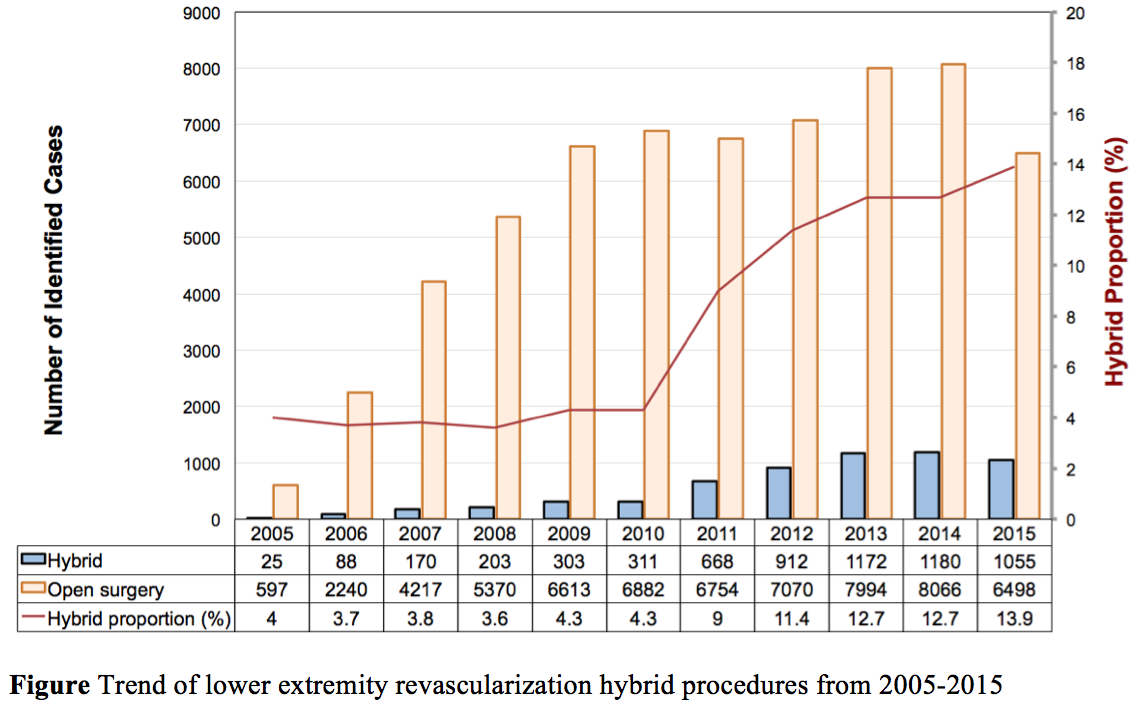National Trends of Hybrid Lower Extremity Revascularization in the ACS-NSQIP Database
Arash Fereydooni, MS1, Bin Zhou2, Saman Doroodgar Jorshery, MD3, Yanhong Deng2, Alan Dardik, MD, PhD3, Cassius I. Ochoa Chaar, MD3.
1Yale School of Medicine, New Haven, CT, USA, 2Yale School of Public Health, Center for Analytical Sciences, New Haven, CT, USA, 3Section of Vascular and Endovascular Surgery, Department of Surgery, Yale University School of Medicine, New Haven, CT, USA.
OBJECTIVES: Despite reports of increasing use of hybrid surgery for lower extremity revascularization (LER) in Europe, little is known about the performance of hybrid procedures in the U.S. This study aims to I) investigate contemporary national trends in frequency and operator distribution of hybrid LER, II) and compare the perioperative outcomes of vascular surgeons and other surgical specialists.
METHODS: The 2005-2015 American College of Surgeons National Surgical Quality Improvement Project (ACS-NSQIP) database was used to identify patients undergoing open or hybrid LER based on Current Procedural Terminology codes. Only patients treated for peripheral artery disease (PAD), based on International Classification of Diseases codes-9, were included. A trend of yearly hybrid LER compared to open LER was obtained. The most commonly performed hybrid procedure was identified as well as the specialties of the primary operators. Patients undergoing this hybrid LER by vascular surgeons were selected and matched (2:1) to the patients who underwent the same procedure by other surgical specialists. Matching was based on age, gender, functional status, American Society of Anesthesiologists (ASA) classification, transfer status, emergent surgery, and indication. The characteristics and perioperative outcomes of those two groups were compared.
RESULTS: The overall rate of hybrid procedures increased from 4% in 2005 to 14% in 2015 (p <0.0001, Figure). During this period, vascular surgeons independently performed 92.9% of all hybrid surgeries, with no significant change in the yearly trend. Femoral endarterectomy with retrograde iliac intervention was identified as the most common procedure, accounting for 24.2% and 25.6% of hybrid LER performed by independent vascular surgeons and other surgical specialists, respectively. After propensity matching, there were 212 patients treated by independent vascular surgeons and 106 patients treated by other surgical specialists, with no significant difference in demographics or comorbidities. There was no difference between vascular surgeons and other surgical specialists in mortality (1.4% and 2.8% respectively, p=0.911), overall morbidity (19.3% and 18.9% respectively, p=0.299), and other complications.
CONCLUSIONS: Hybrid LER for PAD has been increasingly used and is performed primarily by independent vascular surgeons. Simple hybrid procedures can be performed safely by vascular surgeons as well as other trained surgical specialists. 
Back to 2019 Abstracts
